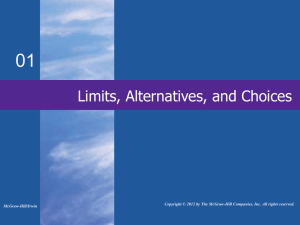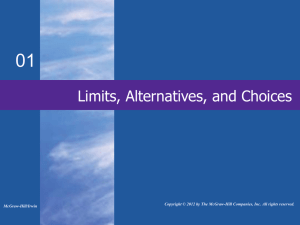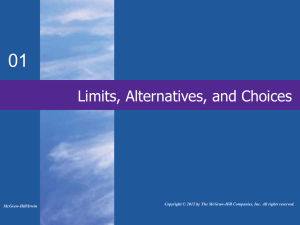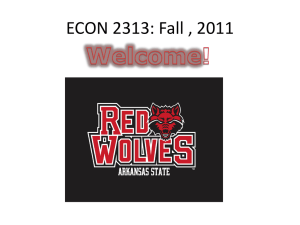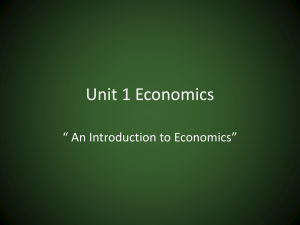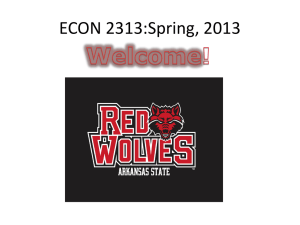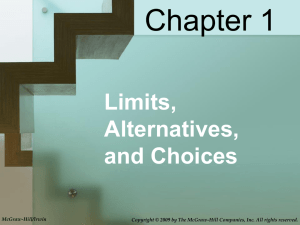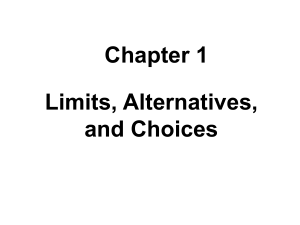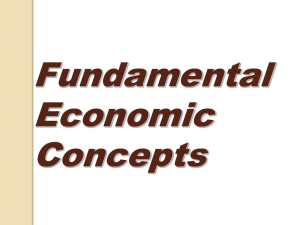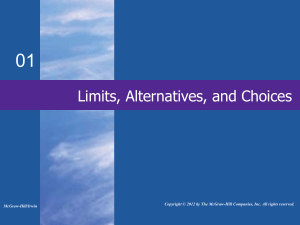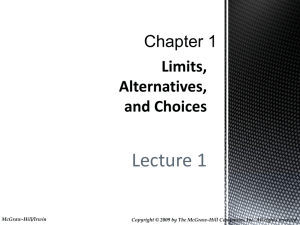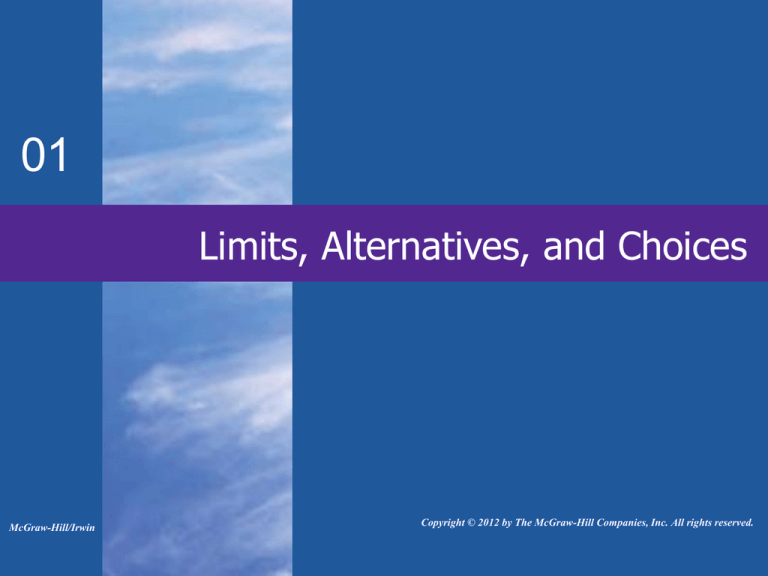
01
Limits, Alternatives, and Choices
McGraw-Hill/Irwin
Copyright © 2012 by The McGraw-Hill Companies, Inc. All rights reserved.
Introduction
LO1
•
•
Economics defined
•
A social science concerned
with making optimal choices
under conditions of scarcity
Economic wants exceed
productive capacity
1-2
The Economic Perspective
LO1
Scarcity and
Choice
Purposeful
Behavior
Marginal
Analysis
• Resources
are scarce
• Choices must
be made
• Opportunity
cost
• There’s no
free lunch
• Rational
self-interest
• Individuals
and utility
• Firms and
profit
• Desired
outcomes
• Marginal
benefit
• Marginal cost
• Marginal
means extra
• MB and MC
1-3
Theories, Principles, and Models
•
The scientific method
Observe
Formulate a hypothesis
Test the hypothesis
Accept, reject, or modify the hypothesis
Continue to test the hypothesis, if necessary
• Economic principles
• Generalizations
• Other-things-equal assumption
• Graphical expression
LO2
1-4
Microeconomics and Macroeconomics
•
•
•
•
LO3
Microeconomics
Decision making by individual
units
Macroeconomics
Examines either the economy as
a whole or its basic subdivisions
or aggregates
1-5
Positive and Normative Economics
•
•
•
•
LO3
Positive economics
Deals with economic facts
Normative economics
A subjective perspective of the
economy
1-6
Individual’s Economizing Problem
• Limited income
• Unlimited wants
• A budget line
• Attainable and unattainable options
• Trade-offs and opportunity costs
• Make the best choice possible
• Change in income
LO4
1-7
Individual’s Economizing Problem
12
DVDs
$20
Books
$10
6
5
4
3
2
1
0
0
2
4
6
8
10
12
10
Quantity of DVDs
$120 Budget
Income = $120
Pdvd = $20
8
=6
Unattainable
6
Income = $120
Pb = $10
4
2
0
Attainable
2
4
6
8
10
12
Quantity of Paperback Books
LO4
= 12
14
1-8
Society’s Economizing Problem
• Scarce resources
• Land
• Labor
• Capital
• Entrepreneurial Ability (takes
initiatives, makes decisions,
innovates, and takes risks)
LO4
1-9
Production Possibilities Model
• Illustrates production choices
• Assumptions
• Full employment
• Fixed resources
• Fixed technology
• Two goods
LO5
1-10
Production Possibilities Model
Production Alternatives
Type of Product
Pizzas
A
B
C
D
E
0
1
2
3
4
10
9
7
4
0
(in hundred thousands)
Industrial Robots
(in thousands)
Plot the Points to Create the Graph…
LO5
1-11
Industrial Robots
Production Possibilities Model
14
13
12
11
10
9
8
7
6
5
4
3
2
1
A
B
Unattainable
C
U
D
The law of
increasing
opportunity
costs makes
the PPC
concave.
Attainable
E
0 1 2 3 4 5 6 7 8 9
Pizzas
LO5
1-12
Industrial Robots
A Growing Economy
14
13
12
11
10
9
8
7
6
5
4
3
2
1
A’
B’
Unattainable
A
B
C’
C
Economic
Growth
D’
D
Now Attainable
Attainable
E’
E
0 1 2 3 4 5 6 7 8 9
Pizzas
LO6
1-13
Present Choices, Future Possibilities
LO6
Future
Curve
Current
Curve
P
Goods for the Future
Goods for the Future
Compare Two Hypothetical Economies
Future
Curve
F
Current
Curve
Goods for the Present
Goods for the Present
Presentville
Futureville
1-14
Pitfalls to Sound Economic Reasoning
• Biases
• Loaded terminology
• Fallacy of composition
• Post hoc fallacy
• Correlation not causation
1-15

